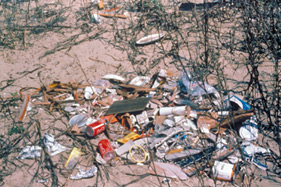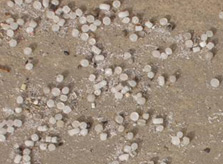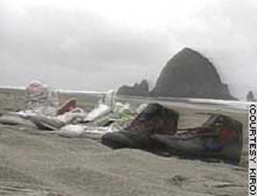|
Overview |
Marine Debris
Marine Debris
Other Resources Related to Marine Debris
Click here for a video of the founder of the Algalita Marine Research Foundation discussing the Great Pacific Garbage Patch.
Click here for images and video from the North Pacific Gyre/Great Pacific Garbage Patch.
Click here for a CNN news video about the Great Pacific Garbage Patch.
|

Marine debris that has washed up on the beach. Credit: NOAA
|
What it is marine debris?
If you have ever walked along a beach and spotted a plastic bottle or other pieces of trash, you have seen the impact of marine debris. Marine debris is litter produced by humans that impacts marine ecosystems. Marine debris takes many forms including fishing nets, plastic trash, cigarette butts, and mermaid tears. Mermaid tears are small plastic pellets that manufacturers use to create plastic toys, bottles, and sports equipment. They are also the name for the remains of larger plastic debris that have been ground down over time. Marine debris affects ocean habitats, the health of marine organisms and humans.
What causes marine debris?
Marine debris is caused by a number of sources. Man made trash enters marine ecosystems by accident, carelessness, and deliberate ways. Storms and accidents at sea can cause container ships to lose part of their cargos during storms. The Great Nike Spill of 1990 was caused by a container ship that was hit by a storm, which sent 5 containers of brand new Nikes into the ocean. Scientists found the shoes all along the coast of the Pacific Northwest. Marine debris is also caused indirectly by people littering in their neighborhoods. This land based litter reaches the ocean by running off into small streams and storm drains that eventually meet the oceans. Marine debris can also be caused by fishermen throwing their used nets into the oceans, beach goers dropping their trash into the oceans, and corporations and factories dumping their wastes into the oceans.

Researchers found a large number of mermaid tears on the beach in Washington. Mermaid tears are plastic pellets that are used to manufacture plastic products.
Credit: Port Townsend Marine Science Center
|
What are some of the impacts of marine debris?
The most detrimental form of marine debris is the type that is non-biodegradable, meaning that the trash cannot be broken down by natural processes. Once these non-biodegradable objects like plastic, nylon, and Styrofoam are produced they become part of the biosphere for tens to hundreds of years. Biodegradable objects like wood and cardboard degrade in a few short years.
Marine debris affects marine ecosystems by destroying habitats, entangling marine animals, killing animals that eat the plastic debris, and destroying coral reefs. The damage that is caused by marine debris is very high. Seabirds like the Sooty Shearwater often mistakenly eat marine debris, which then get stuck in their digestive tracts. Overtime, this can kill the birds because they cannot digest the plastic. Sea turtles and marine mammals often get entangled in ghost nets, abandoned fishing nets, which often kills the animals. Coral reefs are damaged by the marine debris crashing into or getting snagged on the coral. Finally, humans are also impacted by marine debris. Ghost nets and debris can entangle humans swimming or boating in the ocean, and decrease the amount of fish caught during fishing expeditions. Marine debris is one of the biggest threats to marine ecosystems in our time.

Nikes that were washed up on the shoreline of the Pacific Northwest after they were lost from a container ship in 1990.
Credit: CNN
|
What is the Great Pacific Garbage Patch?
The oceans are constantly on the move because of ocean currents, wind, and the Coriolis Effect. Since the majority of marine debris is non-biodegradable, it gets trapped in the oceans. A large amount of this marine debris has been trapped in an ocean gyre, or a swirling vortex of water, in the Pacific Ocean This gyre is located between Oregon and the Hawaiian Islands. This huge amount of marine debris is called the Great Pacific Garbage Patch and it has areas of trash as large as an island. Japan and North America are the main contributors of litter to this garbage patch. Scientists estimate that 80% of the Great Pacific Garbage Patch was at one point land based litter that reached the ocean through streams and storm drains. The Great Pacific Garbage Patch has greatly affected marine ecosystems, and it is an important site for scientists to learn about pollution and its effects.
Research Links Related to Marine Debris
Research Links Related to Exploring Pollution Solutions:
- Alaska Native Harbor Seal Commission
Native Alaskan programs for conservation and preservation of Harbor Seal.
- Birds of New Zealand - 'Titi' Sooty Shearwater
Good color illustrations and fact sheet.
- Caribbean Conservation Corporation -- Loggerhead Turtles
Fact Sheet plus global map of nesting sites
- Cornell Lab - Bird Migration Record (Sooty Shearwater)
Map showing migratory patterns of a breeding pair from their south Pacific colony to the north Pacific feeding ground.
- Monterey Bay Aquarium - Seafood WATCH
This site allows you to print a 'wallet card' which you can carry with you and share with your friends and family.
- National Geographic -- Loggerhead Turtles
Sea turtle profile, photos and video on the lifestyle of the Loggerhead Turtle.
- National Marine Sanctuaries 2008 Accomplishments Report
This is a really cool 2-minute animation on ocean action and a way to participate in the drive to "sea" change.
- National Ocean Service: NonPoint Source Pollution
This link has great background information about nonpoint source pollution.
- NOAA -- Arctic Theme Page -- Polar Bear
Discussion of how climate change is affecting Polar Bear populations.
- NOAA -- Marine Debris Program
Outreach program and education (Marine 101 class) about marine pollution and clean up off New Hampshire coast.
- NOAA Fisheries - Office of Protected Resources - Turtle Excluder Devices (TEDs)
Information on Turtle Excluder Devices (TEDs)
- Nonpoint Source Pollution - A Brief History of Pollution
An article from NOAA's National Ocean Service
- Oil Spills at the Water Surface
An article from NOAA's Office of Response and Restoration
- Penguin Science
How giant icebergs, disappearing sea ice, and shifting weather patterns are affecting penguins. Has a penguin cam plus video and lots of images.
- Pinnipeds.org -- California Sea Lion
Covers distribution and numbers, status and lifestyle. Great photos.
- Pinnipeds.org -- Harbor Seal
Covers distribution, status and lifestyle. Great photos.
- Pinnipeds.org -- Harp Seal
Covers distribution, status and lifestyle. Great photos.
- Pinnipeds.org -- Hawaiian Monk Seal
Covers distribution, status and lifestyle. Great photos.
- Pinnipeds.org -- Walrus
Covers distribution, Status and lifestyle. Great photos.
- Prince William's Oily Mess: A Tale of Recovery
A story with pictures about how the Prince William Sound ecosystem recovered from one of the most infamous oil spills in history.
- Sooty Shearwater tracking
Show migration routes of 19 Sootys throughout the north and south Pacific Basin. Also shows photo of the tracking tag.
- The Problem with Marine Debris
An article from the California Coastal Commission, Public Education Program
- Trash in our Oceans--You Can Be Part of the Solution
An article from the U.S. Environmental Protection Agency
- WWF Loggerhead Turtles
Physical description, ecology & habitat, Population & distribution, threats (bycatch) and importance to marine ecosystems.
|  | 
 | Activities Related to Exploring
Pollution Solutions: |
| |
Predators Among Us
147 KB, pdf
This lesson will focus on human beings as predators, specifically in coral reef ecosystems.
|
 | Other Resources Related to Exploring
Pollution Solutions: |
| |
Why "No Swimming?"
5689 KB, mpeg, audio clip
Our cities and towns affect water quality!
Credit:

Eutrophication
5896 KB, mpeg, audio clip
The effects of eutrophication are discussed in this 6 minute presentation
Credit:

Killer whales provide information
365 KB, mpeg, audio clip
Killer whales can be used as a 'sentinel species' - an indicator both for ocean health and for the health of humanity.
Credit:

Saving the Earth's 'last dinosaurs'
360 KB, mpeg, audio clip
Leatherback turtles are not actually dinosaurs, but they are ancient and amazing animals.
Credit:

Small Changes Add Up
385 KB, mpeg, podcast
People don't realize that little problems cause big issues!
Credit:

Gulf of Mexico Dead Zone
10042 KB, mpeg, podcast
This 10 minute podcast discusses the causes and effects of the huge 'dead zone' in the Gulf of Mexico.
Credit:

|
|



